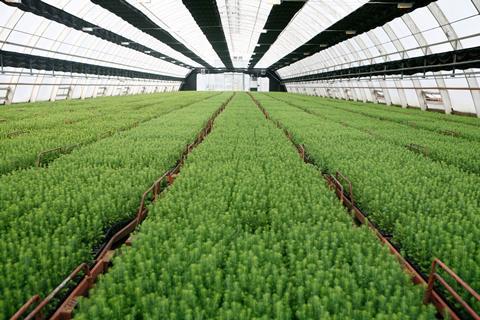
Holmen Iggesund annually produces 35 million seedlings to regenerate forest on harvested land.
In this edition of the Spotlight, Swedish paperboard manufacturer Holmen Iggesund shares 9 key points about the symbiotic relationship between paper recycling and the continual production of fresh fibres.
As consumers step up their demands for more sustainable products, many customers are eager to use recycled paperboard, which plays a key role in creating a circular economy. The good news is that fresh fibre paperboard is part of that same sustainable production chain, playing an equally important role in closing the loop. That’s because a steady source of fresh fibre is necessary to maintain the paper recycling process. In other words, without the continued production of fresh fibre, there would be no recycled paper.
1. Fresh fibre paperboard is produced from wood, a renewable raw material. It is essentially produced from the wood remnants or leftovers from the production of sawn timber used, for example, in construction and furniture.
2. The recycling rate for paper is high compared to other packaging materials like plastic. More than 70 per cent of all paper produced in Europe is recycled into new paper products (Confederation of European Paper Industries). The European Union aims to increase packaging recycling even further by 2030.
3. Recycled paperboard would not exist without a steady input of fresh fibre. This is because recycled fibre eventually reaches its end of life. Therefore, the whole recycling process relies on fresh fibre to keep it going. There is a limit as to how many times paper and paperboard can be recycled as their strength and stiffness diminish with each cycle. Generally speaking, they can be recycled three to seven times, depending on the application.

The forest coverage in Sweden is close to 70%. This is higher than a century ago because of the legislation that obliges anyone harvesting forest to replant it.
4. Eventually it becomes more useful to turn previously recycled cellulose fibres into energy through incineration or composting rather than trying to recycle the fibres once more.
5. Recycled material in paperboard tends to lower the protective properties. To compensate for this, the grammage of the board needs to be increased by as much as 40 per cent to reach a high level of protection and sturdiness. This means that recycled paperboard weighs more than fresh fibre paperboard, which leads to lower efficiency in the printing, packaging, filling and logistical processes.
6. Mixed waste paper is not usually de-inked for paperboard manufacture and may therefore retain traces of inks, adhesives, and other residues. Together, this can give the recycled paperboard a greyish colour.

Fresh fibres bring both dimensional stability and tearing strength to printed pieces and packages. An embellished card such as the one in this photo, which has gone through multiple press passes, would hardly have come out as good without the use of fresh fibres.
7. Fresh fibre is generally a better option than recycled fibre for food packaging due to contamination issues. Fresh fibre paperboard has a higher level of purity. Government regulatory bodies in many countries do not allow recycled paperboard in direct contact with foodstuffs. This is for hygienic reasons and the risk of contamination from ink residues and other substances.
8. High-quality fresh fibre paperboard behaves consistently throughout the conversion and production processes. This leads to fewer production stoppages due to damaged or unattractive packages, helping filling lines to run faster and more efficiently.
9. Holmen Iggesund’s fresh fibre comes from sustainably managed forests in Sweden. The country has been successfully managing and replanting its forests ever since the Swedish Forestry Act was enacted in 1903. This environmental law states that anyone harvesting a forest must regenerate it, and hence there is no deforestation in Sweden. Similar processes also exists today in other European countries, for example the UK.
This content was sponsored by Holmen Iggesund.















